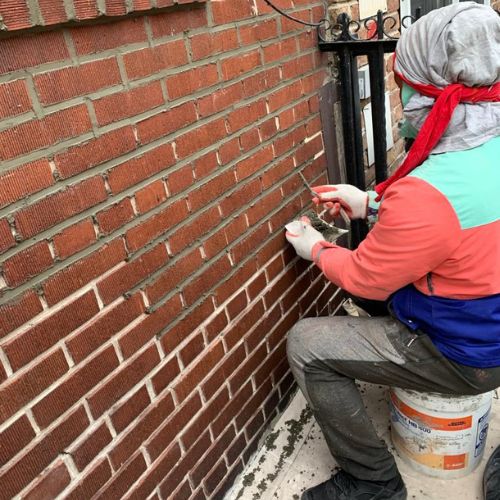Brick Pointing Service
There is something about the stone and brick walls that simply captivates the beholder. These walls are the epitome of beauty and durability, and their value seems to grow with age. However, nothing lasts forever. With time, the bricks and their joints develop cracks and water starts permeating these cracks, stagnating there, while it slowly eats away at both the beauty and durability of the structure.
Moisture and temperature change are the biggest enemies of a building’s brick wall, causing damage to masonry and concrete. They have caused some of the most common problems that can result from harsh weather or improper use of materials or techniques in the original construction.
When these problems are ignored for too long, a fairly large section of the bricks may be affected. Over time, the mortar starts breaking down, and if left ignored, this can lead to a myriad of problems:
- Leaks and the damage or loss of your bricks are some examples of related problems that could result from this.
- Bricks absorb water, which upon freezing will cause outer surfaces to flake off. This in turn makes the structure of the wall vulnerable and as such, should be replaced as soon as possible. Failing to do so will affect larger areas of the structure, which will later become quite expensive to rectify.
- Salt dissolution will further eat into the mortar and bricks, adding to the damage even more.
- Mold and green algae will start to grow along the outside surfaces of the walls and wallpaper will start peeling off internal walls as a sign of dampness having entered the brickwork.
- Cracked bricks may also be a sign of serious problem with your building’s foundation.
To counter all these consequences, it is very important to repair your building’s mortar joints well ahead of time. This is where our brick pointing services come in. Brick pointing is the professional work done by a brick contractor to repair or replace the mortar and mortar joints.
Repointing is the process of renewing the pointing, which is the external part of mortar joints. Repointing is also called pointing or pointing up, although both these terms are more closely related to the process of the finishing step in new construction.
The Process of Repointing Consists of the Following Steps
Examining the Structure
Before beginning the actual work, our contractors at MBH examine the masonry, mortar and techniques that were employed in the original construction process. We look into details and try to deduce where the true problem lies and what is causing the cracks or the damage. Usually, if the crack is smaller than 2mm and is not causing any major problems, we find it better to leave it as is and not repoint. Cracking along old repairs is common due to shrinkage of hard mortar and seasonal expansion and contraction along the joints.
Matching the material
We measure the strength and permeability of the original mortar and match it with the new. This ensures that we find the best match to the existing setup, as it is essential that the mortar used for repointing has performance characteristics similar to the original mortar that was used in the building. Some of these characteristics include permeability, compressive strength, and the degree of thermal expansion.
We also find the best match for the color of the mortar as well as the best match for the tooling.
Testing a Small Panel First
Before starting the work, all the methods and materials for the repointing will be applied in a test panel. A test panel is an area on the structure out of plain sight where the owner or conservator can test the methods that they will use for repointing, the color of the mortar, and the tools and skills of the mason. We believe this is crucial to foresee potential problems before going full-scale.
- Plastering and screeding
- Pointing and repointing of small patches in the wall or entire buildings
- Employment of mild techniques for old buildings
- Repair work on any damages that earlier weak pointing has caused
- Damp proofing and control
When to Avail of a Repointing Service
All kinds of masonry walls, be it brick, stone or block, are subject to gradual erosion due to rain, wind and wind-driven dust and grit. Once the exposed façade of the mortar has receded beyond the face of the outer wall, the joints become even more prone to erosion. This may allow water to penetrate and saturate the wall through the worn-out joints.
The decision to get a repoint done usually comes when you see one or more of the following signs of deterioration:
01.
Disintegrating Mortar
02.
Cracks in the Joints
03.
Loose Bricks or Stones
04.
Damp Walls
05.
Damaged Plasterwork
06.
Holes in the Mortar Joins
Every task calls for a precise decision, based on a wide range of factors. But our expert contractors as MBH Roofing and Waterproofing are experienced enough to predict potential problems at the outset and can thus prevent the repair or recovery task from becoming prohibitively expensive.
Brick pointing or repointing is an important part of building maintenance and should therefore be scheduled strategically. Doing so will save you the expense of getting the job done when it gets too late. Our repoints are long lasting and makes your building look as good as new. Our long list of satisfied clients is a testimony to that.
Get in touch with us if you want our expert contractors to breathe a new life into your bricks walls .
Some of Our Brick Pointing Works






